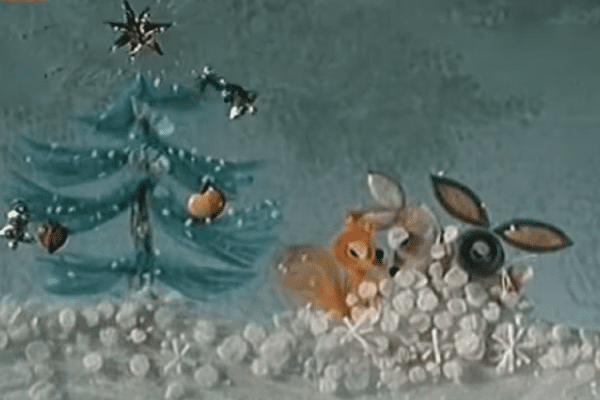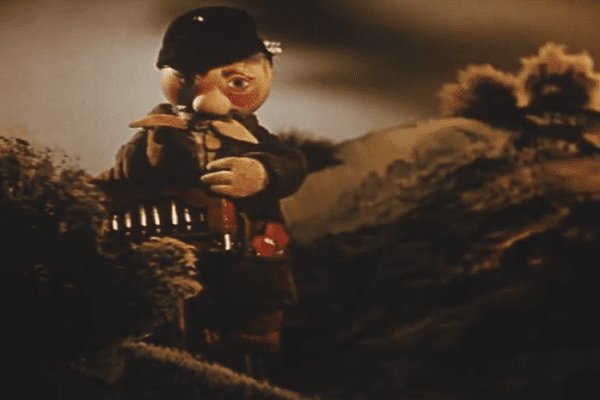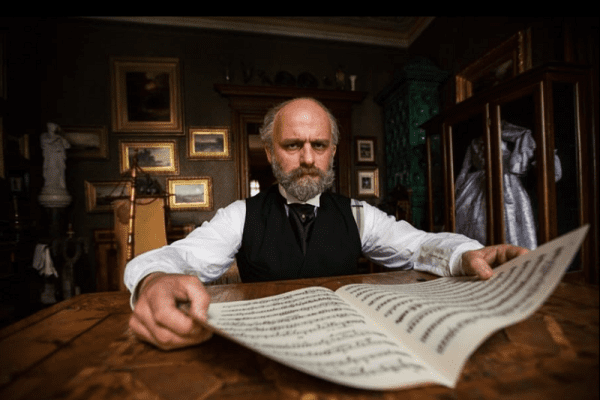In today’s post, I am sharing the song Krysař (the Pied Piper) by Waldemar Matuška. Click to play the video and read the lyrics I have translated for you below. After that, I’m sharing information about a Czech film of the same name by Jiří Barta.
Krysař, which means “The rat catcher”.
First, the lyrics in Czech
Měl šedej plášť, kočičí krok, smutnou tvář,
za pasem nůž a vedle něj kříž a snář.
Ten piják hvězd na stovkách cest polykal prach.
Tisíce mil, krysař to byl a já ho znal,
píšťalku měl, šel kudy chtěl dál a dál,
tisíce mil, krysař to byl a šel z něj strach.
Šel a kam stoup vyrost jak sloup k nebi dým,
na tisíc mil, krysař to byl, já to vím!
Šedivej plášť, kočičí krok, podivnej hráč.
Píšťalku měl, šel kudy chtěl dál a dál
a každej tón, každičkej tón kterej hrál
znamenal smrt, znamenal žal, znamenal pláč.
Hrál slovo “my” a “naše vlast”, “mír” a “čest”
a myslel “Vy” a “Vaše krev”, “válka”, “pěst”,
co musel znát, co uměl hrát svůdnejch not.
Co divnejch slov, co divnejch slok dlouze hrál
a z každý z nich hořící vích horce řval:
“nastoupit v řad, na rámě zbraň, pochodem v chod”!
Teď je tu zas kočičí krok, smutná tvář.
Za pasem nůž a vedle něj kříž a snář,
slyším ho hrát, je to ten tón tenčí než vlas.
To v kostech měst začíná kvést bílej prach,
píšťalka zní a všichni z ní máme strach,
že přijde čas, kdy se ten hlas ozve i v nás.
Vím, chodí dál tak jako dřív prachem cest,
já jsem ho znal, krysař to byl, piják hvězd.
Píšťalku má, křížek a snář, šedivej šat.
A mně se zdá a mně se zdá, že už je čas
říct mu: “už dost”, říct mu: “už dost, vem Tě Ďas”!
“To je náš svět a krysí jed nechcem už brát”!
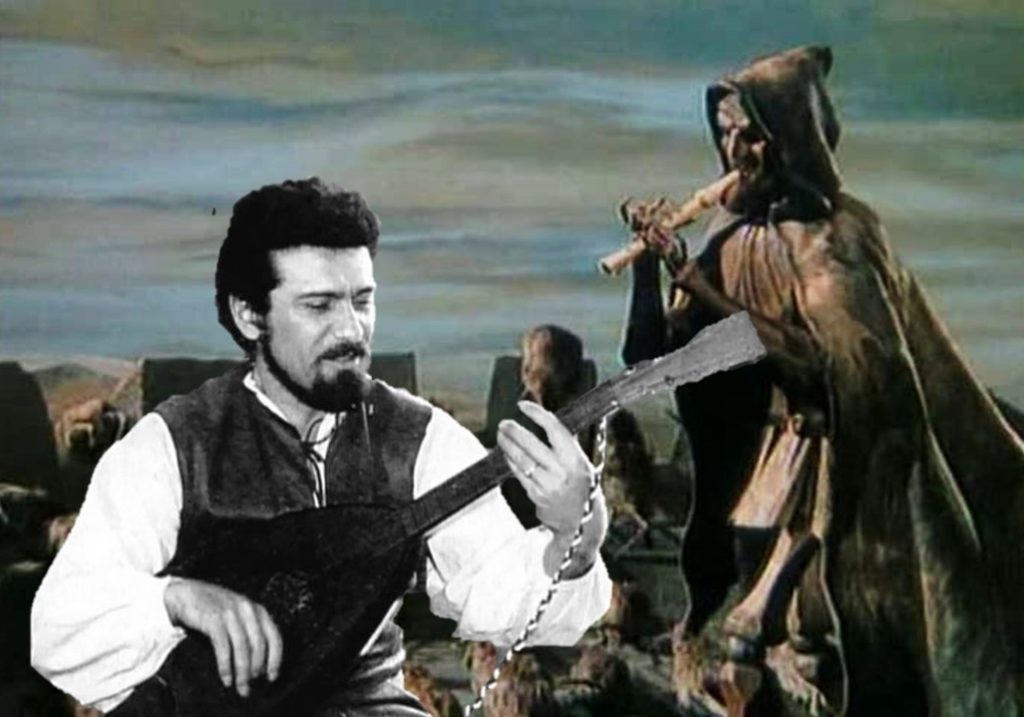
My translation of the lyrics
He had a gray cloak, a feline gait, a sad face,
behind his belt a knife, a crucifix and a dream dictionary.
That drinker of stars on a hundred journeys, he swallowed dust.
Thousands of miles, a rat catcher he was, and I knew him,
he had his flute, and he went where he wanted to go, on and on,
thousands of miles, a rat catcher he was, and he emitted fear.
He went and where he wanted and wherever he went a stump would rise as high as a pillar to the heavens,
for a thousand miles, a rat catcher he was, I know it!
A gray cloak, a feline gait, strange player.
He had a whistle, went where he wanted to go on and on
and every tone, every tone he played
meant death, meaning grief, meaning crying.
He played the word “we” and “our homeland”, “peace” and “honor”
and thought “you” and “your blood”, “war”, “fist”
All he must have known, that he could play such sad notes.
What strange words, what strange slogans he would play
and from each one of them, burning hotter things, enflamed he would shout:
“get in the ranks, take up your arms and forward march”!
Now he is back, feline gait, sad face.
behind his belt a knife, a crucifix and a dream dictionary.
I hear him play, it’s the tone, thinner than hair.
In the bones of the cities, a white dust begins to blossom.
The pipers pipe plays and we are all afraid,
that there will be a time when that sound will awaken in us.
I know it goes on like the dust of the road,
I knew him, he was a rat-catcher, a drinker of the stars.
He has his pipe, a crucifix and a dream dictionary, a gray cloak.
And it seems to me, and it seems to me that it is time,
time to tell him: “Already enough!”, tell him: “Enough, take it yourself!”,
“This is OUR world and your rat poison we will no longer ingest!”
Krysař the film
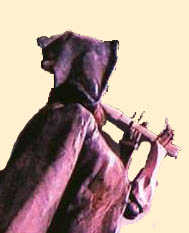
The film Krysař (The Pied Piper, 1985) by Jiří Barta uses horror to teach a lesson of morality and human society. Barta’s adaption of this old tale is a far cry from those of Disney and many others and today we share Ivana Košuličová’s take on the film.
Krysař (The Pied Piper / The Rat-catcher), an animated film from 1985, quickly became a phenomenon within Czech cinematography. Inspired by an old German legend, director Jiří Barta created the film as a fascinating metaphor for the decay of a society focused on material demands. The whole Jiří Trnka Studio was involved in what was one of the most ambitious projects in the history of Czech animation.
The film is an adaptation of a medieval German tale about a pied piper from Hameln. Miroslava Humplíková, writing about the film in Film a doba, traces the story back to a cleric named Samuel Erich was the first to publish this tale, which has its origin in Backhaus’s Hameln Chronicle from the end of 16th century.
Over the next few centuries, the legend spread across the globe, inspiring immortal writers such as the Brothers Grimm, Goethe and Browning, Brecht and Tsvetaeva. Other literary adaptations based on the German legend appeared in Austria, France, Portugual, Spain, Sweden, Syria and China. The tale has also inspired numerous works of music, theater and film.
One of the first film adaptations was made in the United States by Theodore Marstone (The Pied Piper of Hamelin, 1911), followed a few years later by Paul Wegener in Germany (The Pied Piper of Hamelin, 1917). Filmmakers have dealt with this theme using various concepts and genres, ranging from musicals to the horror genre.
Most of the animated film adaptations are children’s films. Walt Disney made two films using the theme of the pied piper at the beginning of his career. In his series of films about Alice that combine live action and animation, there is a film called Alice the Piper (1924). Disney drew on the same inspiration a couple of years later in his famous Silly Symphony (1934).
Barta’s film creates a striking contrast to the Disney conception of the pied piper legend as a children’s comedy.
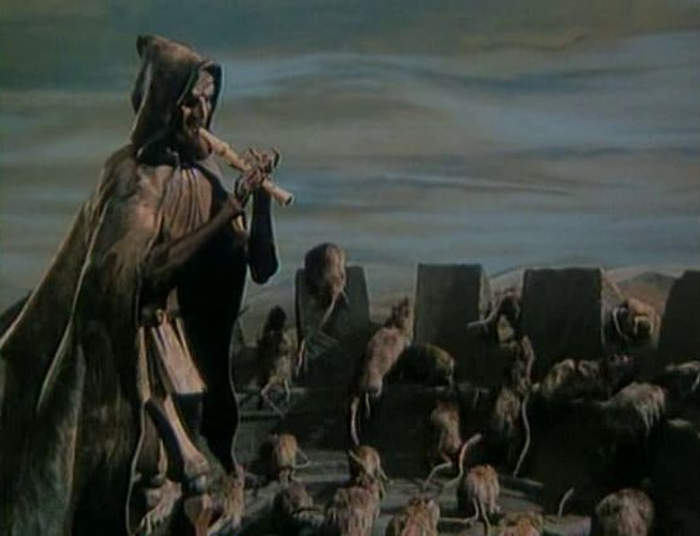
Barta’s adaption is a challenging and metaphoric morality that continues in the Czech tradition of Pied Piper adaptations begun by Viktor Dyk in literature (Krysař, 1915) and Emil František Burian in theater (Krysař, 1940). Burian staged the story as a metaphor for the Nazi occupation in his theater E41 in 1940.
Barta, on the other hand, created a new morality that reflects the decline of socialist society in the mid-1980s.
Towards a happier future?
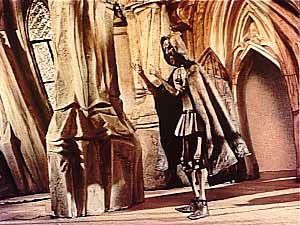 Barta’s conception of the story stresses the analogy between rats and the character of people possessed by the mammon of money. The townsfolk of Hamelin represent the basest human qualities, such as avarice and gluttony.
Barta’s conception of the story stresses the analogy between rats and the character of people possessed by the mammon of money. The townsfolk of Hamelin represent the basest human qualities, such as avarice and gluttony.
Barta has treated this theme in other films, as well, including Poslední lup (The Last Theft, 1987), Balada o zeleném dřevu (Ballad of the Green Wood, 1983), Zaniklý svět rukavic (The Lost World of Mittens, 1982) and Klub odložených (Club of the Abandoned, 1989).
A sharp-edged lesson in materiality
Some citizens of Hameln argue about money in the market, others hide their wealth in their mattresses, still others drink and eat more than is healthy. The town is soon full of rats that are an increasing threat, and they finally overpower the citizens. The rats do not only scavenge for food, but steal the wealth of the greedy people.
The townsmen (for Barta’s Hamelin is a patriarchal society) offer a reward to a mysterious piper in a hood, the rat-catcher who can rid the town of its vermin infestation. The music of his pipe makes the rats follow him, and he leads them to a cliff from which they plunge into the water and drown. Once the town is clean, the citizens return to their sybaritic lives and refuse to pay the pied piper his fee. The same night, the town’s only innocent young woman is raped and killed by drunken townsmen. The next morning, the pied piper takes his instrument and plays music that makes all the sinful citizens metamorphosize into rats and follow him to the cliff. The only survivors are an old fisherman and a baby. When the old man finds the baby, he abandons the town, walking towards a possibly happier future.
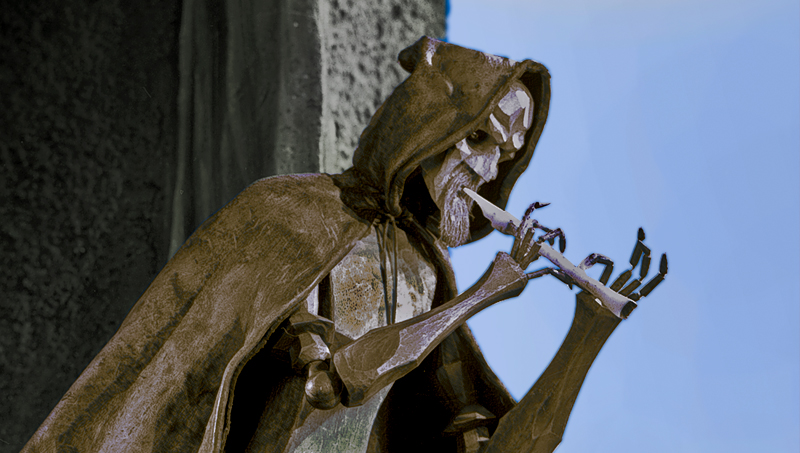
Animated brutality
The director stages the mythological Hameln as a medieval, gothic town in an expressionist, artistic style with twisted lines in the architecture. Different animation techniques are combined: wooden puppets and moving relief, animation of real food, footage of live rats, and oil painting—everything contributes to an ambitious piece of work. Moreover, the director uses the tools of feature film in his range of expression, such as parallel montage, different angles and camera movements and subjective deformed shots. In his hands, animation becomes creative filming with an interesting usage of cinematic language.
Different kinds of puppet are used for specific characters. The townsmen are made of dark walnut wood with square cubist shapes, while the beautiful and innocent Agnes is a puppet made of light wood in a round elegant form that resembles the style of Jiří Trnka. The character of the mysterious pied piper is made from dark wood, shrouded in a hood with deep-set eyes that we cannot see (until the moment of the imminent apocalypse).
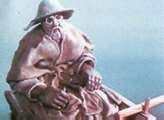 The absence of understandable dialogue—a distinct feature of Barta’s cinematic style—expresses the dehumanization of the townsfolk as well as the universality and continued topicality of the story. The townsfolk “speak” in a “language” that resembles the squeak of rats and foreshadows their future metamorphosis. The innocent characters, such as the piped piper, Agnes, and the old fisherman, remain significantly silent.
The absence of understandable dialogue—a distinct feature of Barta’s cinematic style—expresses the dehumanization of the townsfolk as well as the universality and continued topicality of the story. The townsfolk “speak” in a “language” that resembles the squeak of rats and foreshadows their future metamorphosis. The innocent characters, such as the piped piper, Agnes, and the old fisherman, remain significantly silent.
The music adds an important semantic element to the film. There are three main musical motifs which are interconnected. The music that dominates the film is composed as a cacophony complementing the atmosphere of the corrupt town. The character of the pied piper is represented by electric guitar music, while the third central character in the film, the innocent Agnes, is accompanied by a soft lyric female voice. Composer Michael Kocáb’s music, played by Michal Pavlíček on electric guitar and Jiří Stivín on the flute, evokes an eerie atmosphere of a town fated to be destroyed, a motif that is present in the film from its beginning. The first sequence of the film shows various clocks, the sound of which fills the sound track. This reflects the regularly repeated activities of the townsmen and point up the inflexibility and inescapable fate of Hameln.
 In depicting the rape of beautiful Agnes, Barta stretches the boundaries of animated cinematography. The director combines three different scenes in parallel montage to intensify the suspense. This brilliantly constructed sequence comes immediately after the scene in which the townsmen refuse to pay the pied piper his fee. In the next shot, we see Agnes praying in front of the cross in her house. When Agnes goes to bed, drunken townsmen try to get into her room. The pied piper approaches. Agnes tries to fight them off but finally falls to the floor. The cruel townsmen take her to her bed and prepare to rape her. The drama of the sequence is emphasized by electric guitar music. When the pied piper arrives at Agnes’s home, he finds her lying on the floor and gently closes her eyes. The apocalypse is near.
In depicting the rape of beautiful Agnes, Barta stretches the boundaries of animated cinematography. The director combines three different scenes in parallel montage to intensify the suspense. This brilliantly constructed sequence comes immediately after the scene in which the townsmen refuse to pay the pied piper his fee. In the next shot, we see Agnes praying in front of the cross in her house. When Agnes goes to bed, drunken townsmen try to get into her room. The pied piper approaches. Agnes tries to fight them off but finally falls to the floor. The cruel townsmen take her to her bed and prepare to rape her. The drama of the sequence is emphasized by electric guitar music. When the pied piper arrives at Agnes’s home, he finds her lying on the floor and gently closes her eyes. The apocalypse is near.
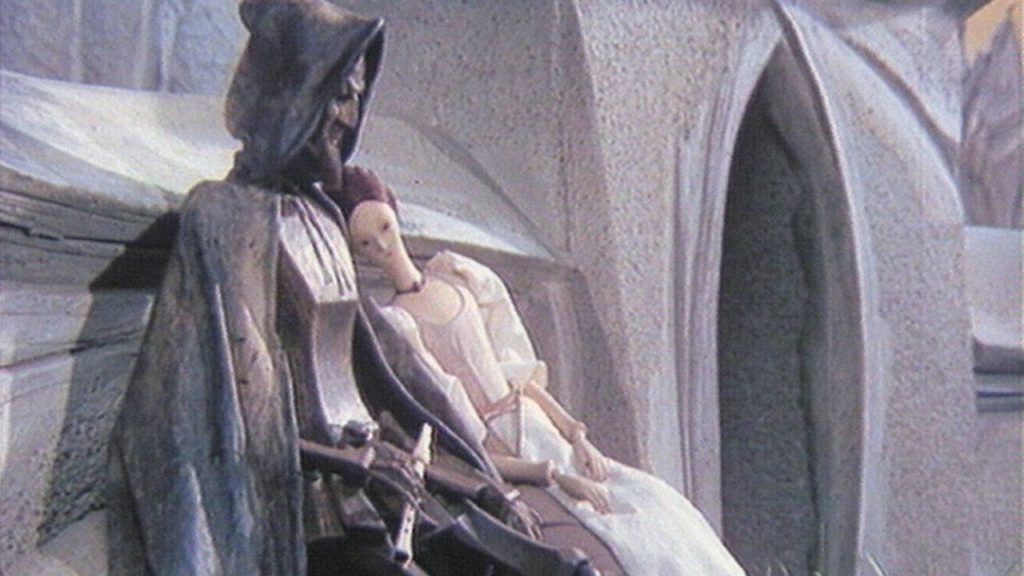
Barta also uses a series of “bloody” naturalistic scenes which show the brutal clubbing of a rat by the townsmen of the film and a butcher killing a bull with an axe, at the beginning.
From Death to the living dead
Barta’s later film Poslední lup (The Last Theft, 1987) takes up the criticism of the ageless vice of man, his material demands and greediness. The story is quite simple. A thief breaks into a crypt where he finds not only various pieces of jewelry but also several vampires sitting at the table. But the thief, blinded by the money, does not see them for what they are and joins them in a game of dice, oblivious to the danger he is in. The vampires let him win, offer him drink, food, and even a bath, and then take him to a bed where they suck his blood. The film balances on the boundary between feature and animated film. Barta uses real actors as puppets and completes the picture with animation techniques.
Once again, Barta creates a fantasy world that reflects the problems of the real one. As with the mythic Hameln, Barta chooses a bizarre, mystical setting. In Poslední lup, it is an old crypt that is a gate to the “other world.” And again the main plot grows out of a confrontation between greedy humans and mysterious beings from the “netherworld.” While the character of the pied piper can be interpreted, in accordance with medieval moralities, as Death, the characters of Poslední lup are clearly vampires waiting for their victim. In a genre that can be called grotesque horror, Barta combines scary and comic moments in a serious parable. Supposedly frightening moments are turned into grotesque farce: for example, when a male vampire dressed as a female nurse equipped sucks the thief’s blood using a special contraption, or when the mysterious vampire realm sinks into the underworld, as on a theater stage.
In these films, Barta creates mysterious horror worlds full of sinful, grasping humans who reflect the decay of human society. Apocalypse for humankind comes from the uncanny beings from the “other side.” Yet, there always remains some hope: in elderly wisdom, in innocent childhood and in the morning that comes after a vampires’ night.
Ivana Košuličová is a postgraduate student of film studies at Masaryk University in Brno and writes regularly for Kinoeye on Czech film.
You can watch the film here:
Krysar (1985) from Nocte Perigea on Vimeo.
Sources:
- Czech Lyrics to the song Krysař.
- The morality of horror, Jiří Barta’s Krysař (The Pied Piper, 1985)
- Krysař (the book) on Wikipedia.
- The Pied Piper film information on Wikipedia.
We tirelessly gather and curate valuable information that could take you hours, days, or even months to find elsewhere. Our mission is to simplify your access to the best of our heritage. If you appreciate our efforts, please consider donating to support this site’s operational costs.
See My Exclusive Content and Follow Me on Patreon
You can also send cash, checks, money orders, or support by buying Kytka’s books.
Your contribution sustains us and allows us to continue sharing our rich cultural heritage.
Remember, your donations are our lifeline.
If you haven’t already, subscribe to TresBohemes.com below to receive our newsletter directly in your inbox and never miss out.


